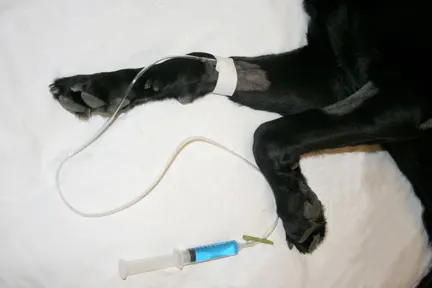
In the Literature
Hess W, Kollias N, Pikel L, et al. Survey of veterinarians who use pentobarbital for euthanasia suggests knowledge gaps regarding animal disposal. J Am Vet Med Assoc. 2023:1-9. doi:10.2460/javma.23.03.0161
The Research …
Pentobarbital is a commonly used euthanasia solution in veterinary patients that is widely distributed throughout the body at the time of death and may remain in body tissue because it is not significantly metabolized prior to death. Pentobarbital may thus pose environmental risks as well as possibility for relay toxicosis in scavenger animals.1 Clients should be informed about these potential risks.
AVMA members (n = 2,093) were surveyed about their understanding of pentobarbital risks while handling euthanized patients and the extent to which potential risks are communicated to clients. Respondents were grouped by type of patient (ie, animals intended for food purposes, animals not intended for food purposes, both) they typically euthanize and answered questions related to pentobarbital euthanasia dose, knowledge of disposal methods, and perceived responsibility for proper disposal.
Findings indicated that 56.5% of respondents adhere to the standard labeled dose of pentobarbital (1 mL/4.5 kg [10 lb] body weight). Those who perform euthanasia in animals not intended for food purposes reported using >1 mL/4.5 kg (10 lb) body weight in dogs and cats more often than those who euthanize both animals not intended for food purposes and animals intended for food purposes. Respondents felt proper disposal of pentobarbital-contaminated carcasses could be the responsibility of the client, clinician, or facility (intended to be an entity separate from the client), depending on the species and circumstances. Clinicians were aware of burial, incineration, rendering, biodigestion, and composting as disposition methods. The method recommended to clients depended on patient species, with incineration being most common for animals not intended for food purposes.
… The Takeaways
Key pearls to put into practice:
Clinicians have a varied understanding of pentobarbital risks. Additional training on disposal types and local, state, and federal regulations is important, especially for recent graduates and those working with suburban or urban populations.
The lowest labeled or recommended dose of pentobarbital to achieve death should be used to reduce the drug volume in the deceased body and risk for relay toxicosis and environmental contamination. Other drugs (eg, diclofenac) in the body at the time of death may raise additional concerns and should be considered when deciding the appropriate disposal method.
Practical, user-friendly educational resources are needed to inform clients and facilities about risks associated with pentobarbital in deceased patients. Clients should be encouraged to follow body disposition recommendations.
You are reading 2-Minute Takeaways, a research summary resource presented by Clinician’s Brief. Clinician’s Brief does not conduct primary research.